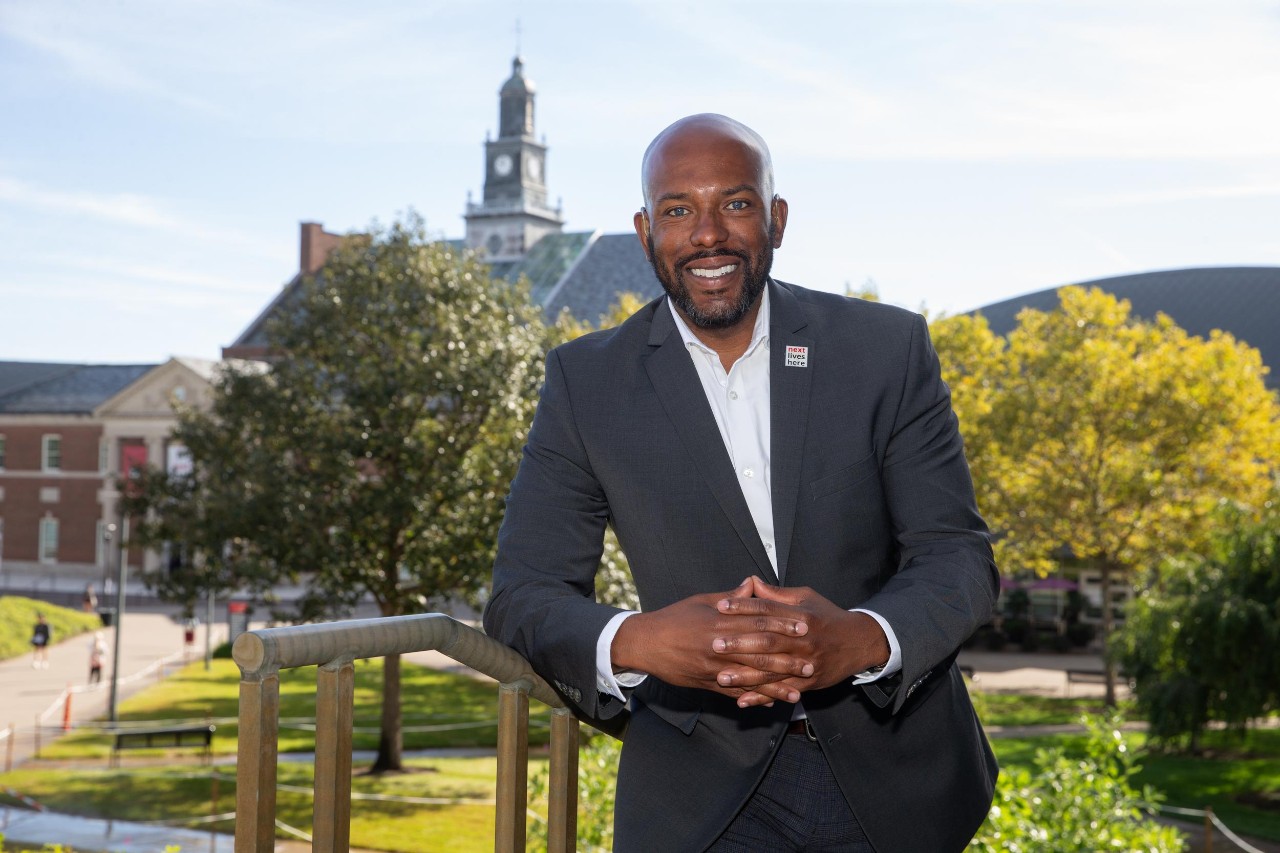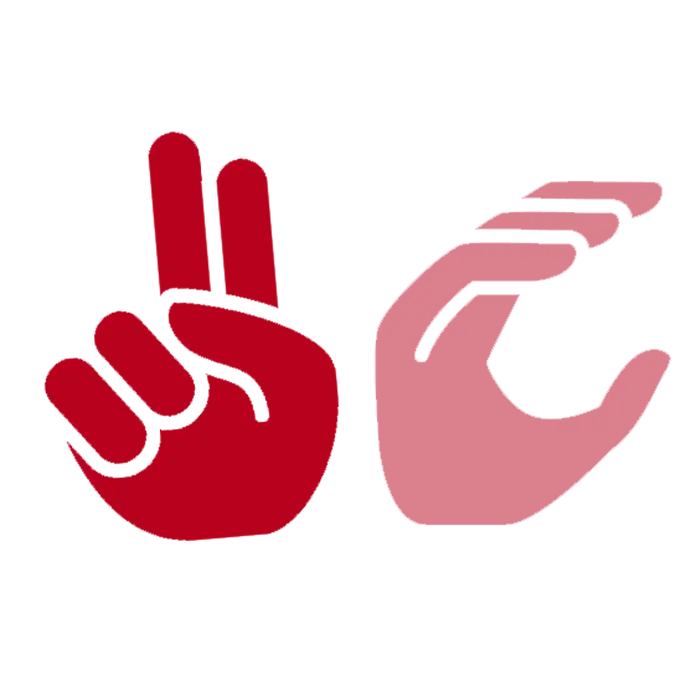A sixth
sense
Long-lost cousins reunite at UC, while taking sign language classes
It is a common belief that deaf people have a heightened sense of the other physical senses — touch, smell, taste or sight — but the science is mixed on whether this is true.
There is no doubt, however, that UC American Sign Language (ASL) instructor Deanna Herbers, who is deaf, has a heightened sense of intuition.
Last fall, on the first day of class, Herbers noticed that two hearing first-year students in different ASL1 beginner classes were already quite proficient in sign language.
It seemed odd, Herbers says through an ASL interpreter, because typically those who take the class are hearing students that come in with little to no ASL skills or knowledge.

UC students Brandon Mueller and Juliette Laracuente-Huebner get a kick out of how their ASL instructor Deanna sleuthed to find out the students were related. Photo/Andrew Higley/UC Marketing + Brand
A few classes in, Herbers was increasingly surprised that these two students, Juliette Laracuente-Huebner and Brandon Mueller, weren’t enrolled in advanced ASL classes, she says, when “they had clearly socialized with deaf people before.”
Call it instinct or intrigue, Herbers felt there had to be more to their backstory. She slowly started to ask personal questions: “It’s part of deaf culture to ask, ‘Where are you from?’ ‘Where did you go to school?’” she says, but didn’t want to seem too forward and there was little time between classes to do a deep dive.
Finally, after three weeks of information exchanges between Herbers, the two students and their family members, the mystery was solved: Laracuente-Huebner, a speech-language-hearing major, and Mueller, a finance major, learned they are third cousins, but had not seen each other since they were toddlers.

Engineering major Brandon Mueller | Photo/Andrew Higley/UC Marketing + Brand
“I got chills,” Herbers says of learning that Mueller’s grandfather is the uncle of Laracuente-Huebner’s grandfather and that the two deaf elders still see each other on a regular basis.
“They are about the same age, in their 70s, and are more like brothers,” Laracuente-Huebner says, explaining their grandfathers' roots on the outskirts of Columbus, Ohio, go back many generations. Her grandfather was one of three deaf siblings; Mueller’s grandfather was one of twelve children, three of whom were born deaf and had deaf children — so the extended family learned sign language at an early age.
Notably, her grandfather, Jerry Huebner, 71, served on a committee that brought the Ohio Relay system — which uses teletype for deaf persons to communicate — to the state. Read more about the technology.
Over time, the cousins' parents moved to different Ohio municipalities and the University of Cincinnati connection just got overlooked, says Mueller. “They probably mentioned it in passing,” but the extended family is large, and family reunions have been few and far between since he was young.
Closing a gap: ASL and Deaf Studies at UC
In an academic year, approximately 1,200 UC students take an ASL or Deaf Studies course — housed within the College of Education, Criminal Justice, and Human Services — with 83 earning their Deaf Studies Certificate in 2023. The UC Deaf Studies program is touted as the largest program among only 12 universities in the U.S. offering certification. There are eight full-time faculty and various adjuncts who teach the classes and ASL interpreters are provided for faculty and students when needed, through UC’s Office of Accessibility Resources.
Students often enroll in my ASL classes to fulfill their foreign language requirements. Additionally, some students take ASL to learn how to communicate with deaf family members or friends. Many are also drawn to ASL because they want to study a language that's different from spoken languages like Romanian, German or Italian. ASL, as a visual language, offers a unique learning experience, and students are curious to explore this. ASL is quite popular here at UC.
Hearing students usually take ASL classes, Herbers says, because they have a deaf friend or immediate family member who is deaf, or they need language credits and are hesitant to take Romance or Germanic languages.

Speech-hearing-language major Juliette Laracuente-Huebner | Photo/Andrew Higley/UC Marketing + Brand
While the cousins grew up communicating with their grandparents in sign language and took ASL courses in high school, Mueller says he chose ASL at UC to fulfill a language requirement, and Laracuente-Huebner says she wants to incorporate sign language into her future career as a speech pathologist. “There seems to be a gap between speech pathologists and audiologists and the Deaf community,” she says.
And an even wider gap exists between the Deaf community and the hearing community at large, says Christopher Johnson, assistant dean of inclusive excellence at UC’s recently formed College of Cooperative Education and Professional Studies (CCPS), who spearheads the inclusive excellence strategic plan for CCPS.
Johnson, who has been deaf since birth, is the first Black, deaf assistant dean at CCPS and among only a “handful” of deaf higher education deans at traditional academic institutions nationwide, he says through an ASL interpreter.
Only 0.4% of people who are both deaf and Black or brown hold doctoral degrees, he adds.

Dean Christopher Johnson | Photo/Andrew Higley/UC Marketing + Brand
He advocates that more hearing students, especially those in co-op, enhance their cultural competency by taking not only ASL classes but disability studies courses to spark their intellectual diversity in each of their classrooms.
“This will align with their future professional opportunities to improve their customer interactions and reduce the sense of awkwardness when encountering people with disabilities,” he says, referring to his own lifelong experiences.
Johnson’s own life story — fraught with struggle in the hearing world — is told on his website.
Read a full interview with Johnson on UC News.
At the time of Johnson’s interview at a college coffee bar, he was unexpectedly but excitedly greeted with sign language by the barista, UC information technology graduate Daniel Hickman, who works there part time while attending seminary. The two had never met before.
“I think ASL is a useful tool for everyone, whether they are integrated into the Deaf community or not,” says Hickman, explaining that he was taught a few words as a child, gained further interest at church and “was very excited when I discovered I could learn more ASL at UC.” Hickman took all four levels of ASL, he says, and engages whenever he sees an opportunity.

UC ASL instructor Deanna Herbers | Photo/Andrew Higley/UC Marketing + Brand
The greater Deaf community
Given that the Deaf community nationwide is small (approximately 1.9% of Americans are deaf or hearing impaired), the odds of hearing, third cousins running into each other in an ASL class on UC’s campus are astronomical, says Elizabeth Jean-Baptiste, an associate professor with the university’s ASL and Deaf Studies program for 13 years. “To my knowledge, it has never happened before,” she says, citing UC’s decades-long history of offering ASL classes prior to the establishment of a Deaf Studies Certificate in 2004.
Overall, in the United States, among people aged 25-64, an estimated 8.1% of deaf people have completed a master's degree or higher, compared to 14.3% of hearing people, according to the National Deaf Center.

Juliette Laracuente-Huebner with her grandparents. Photo/provided
Relatives of the Deaf community are sometimes connectedthrough the organization KODA/CODA (Kids/Children of Deaf Adults). The children grow up in households with one or two parents who are deaf or hard of hearing and where ASL or another sign language may be the primary means of communication. CODA camps are popular across the country, but have a stronger presence in the Midwest. The acronym has gained some mainstream recognition thanks in part to the Oscar-winning 2021 film “CODA.”
Laracuente-Huebner and Mueller are considered Grandchildren of Deaf Adults or GODAs. She had the opportunity over the summer to visit her grandparents. “They definitely think my ASL has improved,” Laracuente-Huebner says.
Given the degrees of separation, Herber says it’s natural that there might not be the same level of connectivity among GODAs as with CODAs. So, the odds of the cousins meeting at UC increase even more when one considers that heredity factors into deafness in only 10% of the deaf population.
These UC students are indeed a rare breed of Bearcat.

Become a Bearcat
Whether you’re a first-generation student or from a family of Bearcats, UC is proud to support you at every step along your journey. We want to make sure you succeed — and feel right at home.
Additional credits
Photos and videos: Andrew Higley, unless otherwise noted
Digital design: Kerry Overstake
UC Marketing + Communications
Related Stories
Young, gifted and Black
April 4, 2022
A Seat at the Table content series looks to explore the experiences and identities of diverse student populations at UC while shedding light on support, resources and opportunities available at the university.
Good neighbors, better partners
June 10, 2020
UC, Cincinnati Public Schools work together to create something special at a new school.
Hope after hate
June 10, 2020
UC professor and Emmy Award-winning journalist shares her father’s Holocaust survival story with lessons to inspire action against hatred and bigotry today.
Remotely possible
When did the COVID-19 pandemic first make an impact on your life? March 10? That was the day the University of Cincinnati decided to change something it has excelled at for 200 years. Teaching. Educating. That day UC announced that all lectures in classrooms, experiments in labs or designing in studios would be suspended. Students started what was expected to be just an extended spring break, but then 12 days later all courses had gone virtual to protect the university community and stop the virus’s spread.
A milestone centennial
March 8, 2021
In 1920, UC became the first university in the nation to open cooperative education — founded at UC in 1906 — to women.
‘Somos familia’
April 26, 2023
“Somos familia” means “we are family,” and students from throughout the Latinx community are building family, finding success and continuing a legacy at UC.
